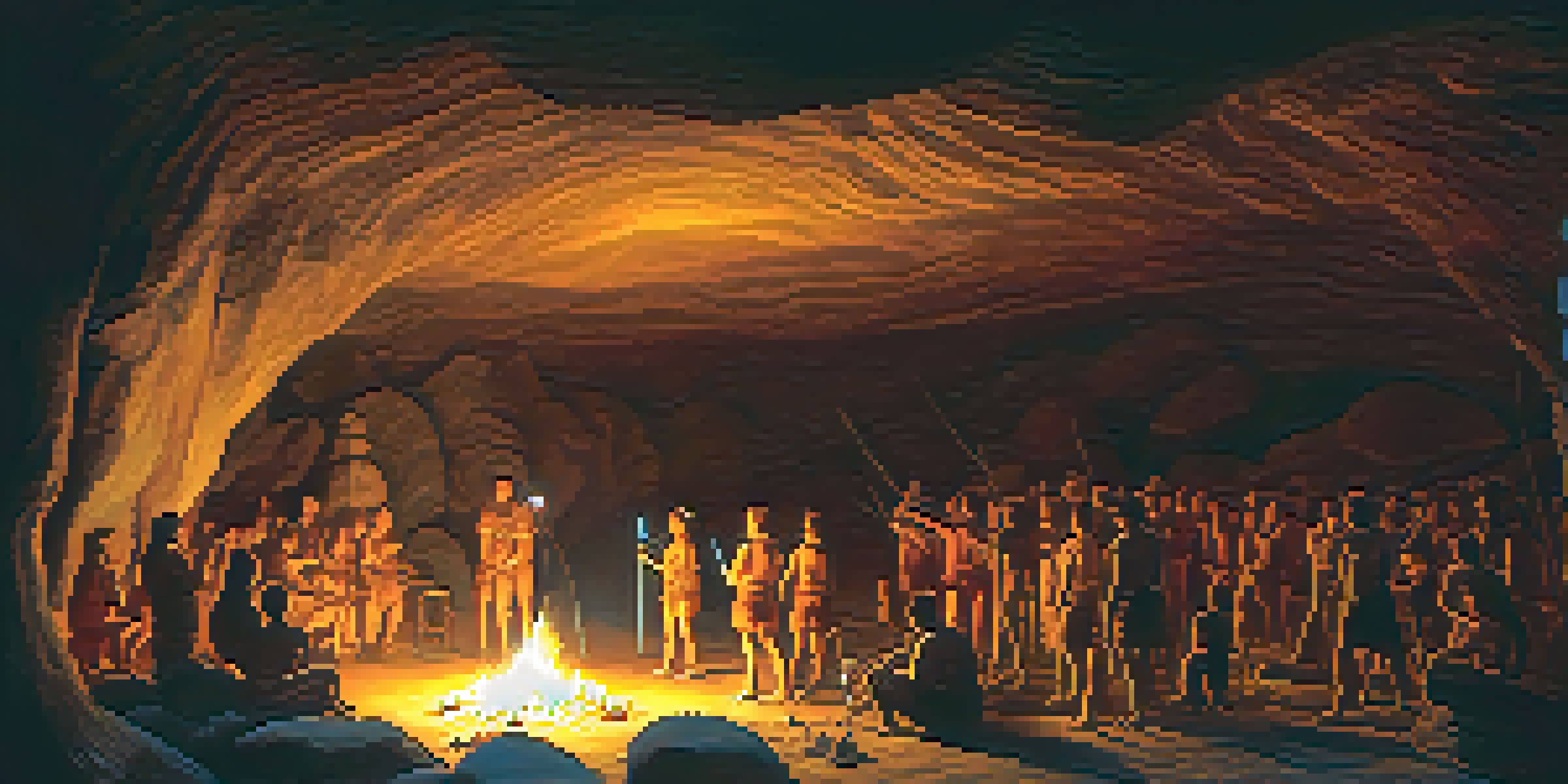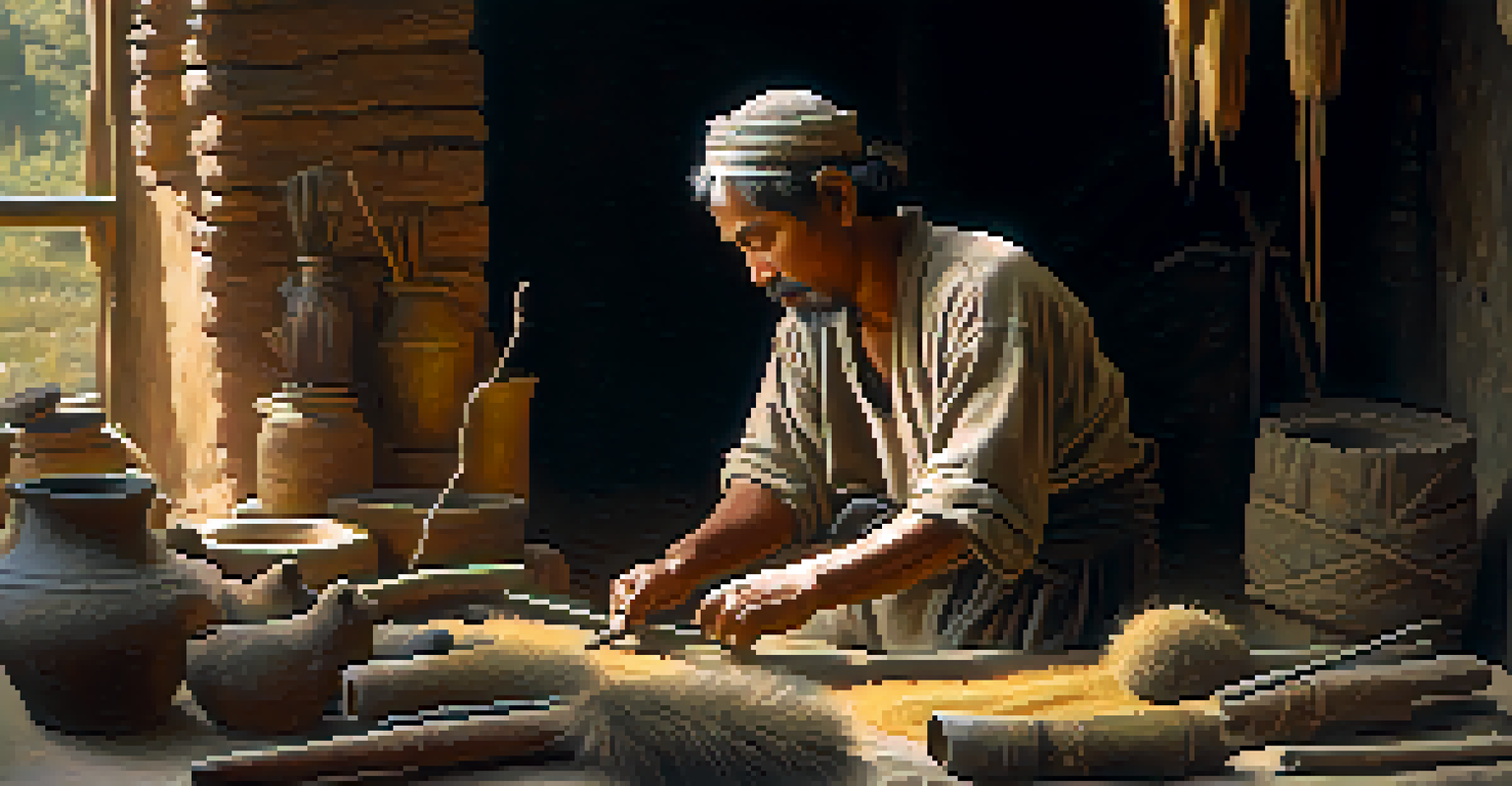The Origins of Painting Tools: From Prehistoric to Ancient Times

The Birth of Artistic Expression in Prehistoric Times
Long before the first human civilizations emerged, our ancestors were already expressing themselves through art. The earliest known forms of painting can be traced back to prehistoric times, where cave paintings depicted animals, hunting scenes, and abstract symbols. These artworks were created using natural pigments derived from minerals, plants, and charcoal, reflecting the environment and experiences of early humans.
Art is not freedom from discipline, but disciplined freedom.
Imagine early humans, gathering around a fire, using their fingers or rudimentary tools to create striking images on cave walls. These paintings served not only as a form of communication but also as a way to record their stories and beliefs. The act of painting was likely a communal activity, fostering bonds within tribes as they celebrated their shared experiences.
This early artistic expression laid the groundwork for the tools that would evolve over millennia. As societies developed, so too did their methods of painting, leading to more sophisticated techniques and tools that would shape the future of art.
Natural Pigments: The Foundation of Early Painting Tools
In prehistoric times, the use of natural pigments was essential for creating artworks. These pigments were made from earth minerals, such as ochre, and other organic materials that were ground into powders and mixed with water or animal fat. The colors ranged from earthy reds and yellows to deep blacks, providing a vibrant palette for early artists.

For example, the use of red ochre in ancient cave paintings not only added color but also held cultural significance, often associated with blood and life. This connection to nature and environment made the pigments deeply meaningful, as they were often sourced directly from the artists' surroundings. As these early painters experimented with different materials, they laid the groundwork for the future discovery of synthetic pigments.
Art's Origins in Prehistoric Times
Early humans expressed themselves through cave paintings, using natural pigments to communicate stories and experiences.
The development of these natural pigments was a turning point in the evolution of painting tools. It allowed artists to express a wider array of emotions and stories, transforming art into a more complex and rich form of communication.
The Invention of Primitive Brushes and Tools
As artists sought to enhance their techniques, they began creating primitive brushes and tools. Early brushes were made from materials like animal fur, reeds, or plant fibers, allowing for more delicate and precise application of paint. These innovations marked a significant shift from using fingers or rudimentary implements to a more refined approach to painting.
The artist is not a special kind of person; rather, each person is a special kind of artist.
Imagine an artist in ancient times, carefully crafting a brush from a bundle of soft animal hair tied to a stick. This simple tool opened up new possibilities for detail and texture in their artwork. The ability to control brush strokes allowed for a greater representation of the subjects they painted, enriching the storytelling aspect of their work.
The invention of these early painting tools was crucial in the evolution of art, setting the stage for more specialized tools in later civilizations. As artists refined their techniques, the quest for better tools and materials continued, leading to advancements that would shape the future of painting.
The Role of Ancient Civilizations in Tool Development
As societies progressed into ancient civilizations, the demand for art and decoration grew, leading to further innovation in painting tools. Cultures such as the Egyptians, Greeks, and Chinese began to develop more sophisticated tools and techniques, incorporating new materials into their painting processes. This period saw the creation of specialized brushes, palettes, and even early canvases.
For instance, the ancient Egyptians utilized reed brushes for their stunning wall paintings, often depicting religious and daily life scenes. They also experimented with pigments made from minerals and plants, showcasing a rich palette that included vibrant blues and greens. This commitment to artistry and detail reflected their deep cultural values and beliefs.
Evolution of Painting Tools
The development of primitive brushes and refined techniques marked a significant advancement in the art of painting.
The advancements made during this time not only influenced their own art but also set the stage for future generations. As knowledge about painting tools and techniques spread through trade and conquest, the foundations of modern art began to take shape.
The Influence of Cultural Practices on Painting Tools
Cultural practices played a significant role in shaping the tools and techniques used by ancient artists. Different civilizations had unique beliefs and traditions that influenced their artistic expressions. For example, in Mesoamerica, the use of vibrant colors and intricate designs in murals was often tied to religious and ceremonial practices.
In Japan, traditional painting techniques, such as sumi-e (ink wash painting), developed alongside a deep appreciation for nature and simplicity. Artists used brushes made from animal hair and specific inks to create delicate and expressive artworks, showcasing the harmony between art and the natural world. These practices emphasized the importance of tools that conveyed their cultural narratives.
By understanding the cultural contexts behind these tools, we gain insight into the motivations and inspirations of ancient artists. This connection between culture and creativity highlights the richness of human expression and the evolution of painting tools throughout history.
The Shift to More Advanced Materials and Techniques
As time progressed, painting tools continued to evolve with advancements in materials and techniques. The introduction of new mediums, such as oil and watercolor, transformed the way artists approached their work. These innovations allowed for greater versatility and experimentation, resulting in a broader range of artistic styles.
For example, the emergence of oil paints during the Renaissance provided artists with the ability to create luminous colors and intricate details. This shift in materials led to the development of new brushes and palettes specifically designed for oil painting, changing the landscape of art forever. Artists like Van Eyck and Titian took full advantage of these advancements, pushing the boundaries of creativity.
Cultural Influence on Art Tools
Different civilizations shaped their painting tools and techniques based on their unique cultural practices and beliefs.
The evolution of painting tools reflects the ongoing dialogue between artists and their materials. As new techniques emerged, so did the need for better tools, creating a continuous cycle of innovation that has shaped the art world.
The Legacy of Ancient Painting Tools in Modern Art
The impact of ancient painting tools can still be felt in modern art today. Contemporary artists often draw inspiration from the techniques and materials used by their ancestors, incorporating them into their own unique styles. This connection to the past highlights the enduring legacy of painting tools throughout history.
For instance, many modern artists are exploring natural pigments and traditional brush-making techniques, embracing the simplicity and authenticity of ancient practices. This revival of interest connects contemporary art with its historical roots, fostering a deeper appreciation for the artistry and craftsmanship of the past.

As we reflect on the journey of painting tools from prehistoric to ancient times, it's clear that their evolution has shaped not only the art itself but also the artists who create it. The story of these tools is a testament to human creativity and the unbroken thread of artistic expression that continues to thrive today.